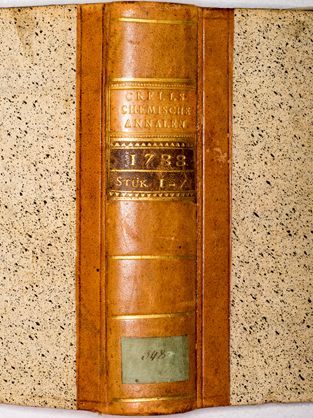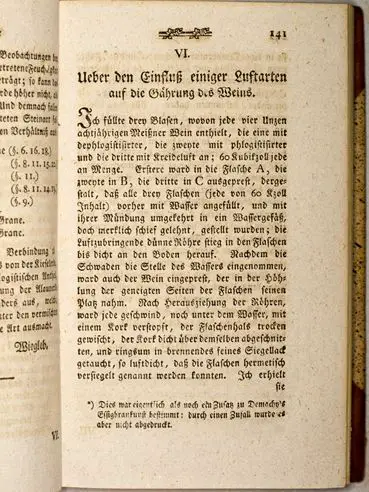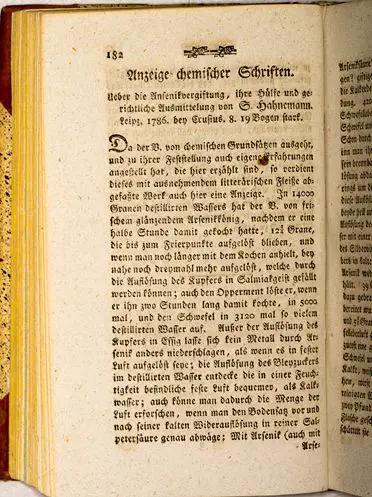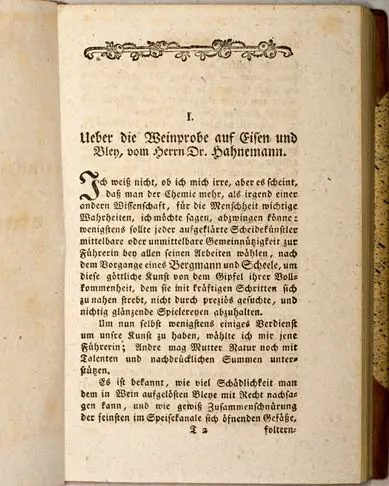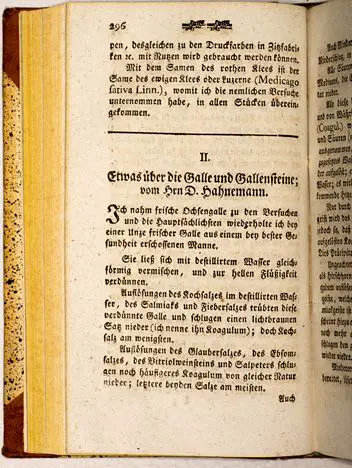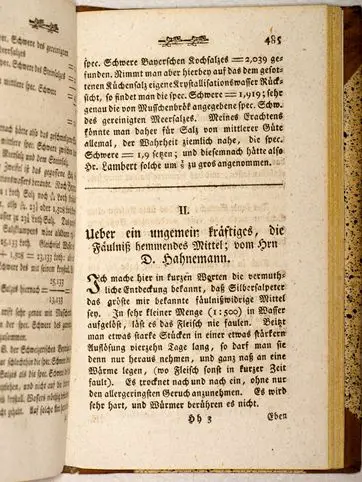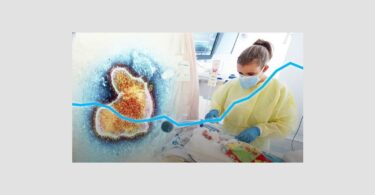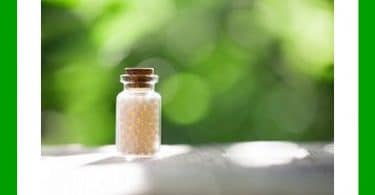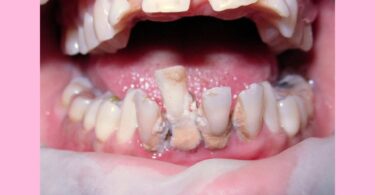Abstract: Dr. Samuel Hahnemann was a chemist, pharmacologist, physician and homeopath. With this and other essays, the International Hahnemann Center Torgau tries to display his contribution to the development of all these sciences. Many of his findings are relevant to this day. Our historic books are witnesses to that time period and we should present them to you for a better appraisal of Hahnemann’s accomplishments.
1788-1789: Crell’s Annals of Chemistry Part 2: Hahnemann’s Writings.
It was in 1788 when Hahnemann published his third translation of French chemist Jacques-François Demachy’s Art of manufacturing vinegar. Hahnemann’s favourite subject at the time was chemistry, a new science. Down to the present day we read historians on homeopathy like Haehl and Ameke claiming that Hahnemann was a self-educated chemist, an autodidact. Even though he surely read and learned much on his own in international literature, there are interesting hints given by Rudolf Tischner in his 800 pages of ‘History of Homeopathy’ ( Geschichte der Homöopathie): it was the founder of homeopathy who said that Leonhardi was his teacher.
The first mention of this lecturer is found in his translation of Cullen’s ‘Materia medica’, vol. 1, pg. 252 (‘Only recently my cherished teacher Leonhardi [Diss. Physiologia muci, Viteb. 4., 1789, pg 11,12] segregated milk sugar [lactose] from mucus of animals), and the other is in vol. 2, pg 443 (.. of my gracious teacher Leonhardi…).
Johann Gottfried Leonhardi (1746 – 1823) taught medicine and chemistry in Leipzig. In a letter of July 10, 1791, Hahnemann mentions a visit of Leonhardi at his house in ‘Stetteritz’, near Leipzig. It is not known when Hahnemann had been student of Leonhardi’s lectures.
A gap in Hahnemann’s biography suggests that he studied Chemistry between the summer of 1779 and the summer of 1780. Now, in 1788, we see Hahnemann writing essays and comments talking about his own experiments. The first one in Crell’s Annals of Chemistry that year is an addition to the translation of Demachy’s ‘Art of manufacturing vinegar’ which got missed being published there.
It is about an experiment done with 8-year-old wine from Meissen. During those days, alcoholic beverages attracted much of his inquiring mind. Obviously, pleasures of life were not quite strange to the later founder of homeopathy. Now, what did he do?
He filled three stills with wine, adding different types of air into each. The first (No. 1) got dephlogisticated air (oxygen), the second (No. 2) phlogisticated air (nitrogen), the third (No. 3), ‘cretaceous air‘ (Kreideluft, carbon dioxide). These components of air were already known.
Hahnemann had filled the bottles with water and put them upside down into a water container. Then he pressed the different gases into the bottles, ousting the water. Finally he pressed wine into the bottles and sealed them hermetically with corks – still under the water – and then with sealing wax.
For two months he kept the bottles at a temperature of 70-80° F. Three times a day he shook the bottles with 30 strokes. The wine in each of the bottles got dreggy – in bottles 1 and 3 just a little bit, in bottle 2 considerably more.
One could see white mold swimming on the wine in bottle 2. After opening the bottles, the air of bottle 1 blurred limewater [which is Ca(OH)2(aq), a saturated solution of calcium hydroxide].
The wine was still tasty. Interestingly enough, within 24 hours the wine turned to stinging wine vinegar. Wine No 2 smelled moldy, the taste was flat. Wine No 3 was fizzy and smelled and tasted like champagne. It remained a good wine for more than eight days.
Next in the Chemical Annals we find a book review on one of Hahnemann’s writings of 1786: ‘On arsenical poisoning, its treatment and judicial detection’. It is signed with the letter ‚G‘. The writer tells “As the author takes chemical principles as a starting point, and because he confirmed them by his own experiments which are here recounted, this product of exceptional literary industry deserves to be noticed by us.”
Hahnemann’s investigations are then described. The review ends with the conclusion that the most reliable ways to recognise the presence of Arsenic are by lime water [Ca(OH)2(aq)], which is saturated with‚ Schwefelleberluft (which is Hepar sulfuris with Hydrogen gas [reference: Alexander von Humboldt in ‚Bergmännisches Journal‘, 1796]) and solution of copper in ammonium hydroxide [NH4OH].
Hahnemann explains very accurately how the material needs to be produced and applied in order to receive reliable results. Indeed, these findings were used in jurisdiction for quite some time.
Ameke, who wrote ‘History of Homeopathy – its History and its Conflicts’ relates an anecdote that Hahnemann, in despair regarding the guesswork about the composition of Arsenic written by other authors, once exclaimed: ‘O holy chemistry, have mercy upon us!“
For our readers who have got a copy of the translation of Ameke’s book by R. E. Dudgeon: On pg. 22 Ameke was mistaken when quoting Professor Hencke that Hahnemann discovered the reaction of Arsenic with ammoniaco-muriate [NH4Cl] of copper. Hahnemann wrote Salmiakgeist, which is [NH4OH].
In the fourth part of Crell’s Annals of Chemistry in 1788, on 15 pages Hahnemann wrote again about wine. It is about probing wine for iron and lead.
In this essay we read about the importance of chemistry not only for Hahnemann but for humanity. He tells us that from this ‘divine art’, more than from any other, one can wring important truths for the people.
Chemistry advances towards perfection with great strides and he chooses working for it so he will be given at least some credits for this art. It is known that lead dissolved in wine causes much harm (he lists some symptoms) and death. The current method (Wuerttembergische Weinprobe – Wuerttembergian wine test) of testing wine for lead precipitates lead, but also iron, copper, silver and other metals to make it impossible to identify the sediment.
Due to this unreliable method, innocent vendors of wine faced the calamity of falling into the hands of those who lack knowledge and who are authorised by legal powers. Hundreds of times not lead but iron was found and chemistry could have opened the eyes of medical jurisprudence in all these cases.
The honour and wealth of families got ruined due to this faulty Wuerttembergian testing of wine. Hahnemann gives the example of a vintner in Dresden who in 1777 lost his livelihood first, and after that two pharmacists proved that only a trace of iron was present in the wine.
Hepar sulfuris (which was used for tests) could cause turbidity already when being dribbled into the wine – even when no metals were present. This fact alone renders the reagent useless. It would be ideal to have a reagent which not only proves the presence of a metal but which also identifies it, or at least proves the presence of a metal different from iron.
A trace of iron always could be present in wine. Now, because ‘thousands’ of vintners face lawsuits for wine doctoring due to faulty arsenical tests, Hahnemann tried to find a better method. In the next paragraphs he discusses different methods which are not suitable for this purpose. He then focuses on the identification of iron and lead. Hahnemann tried eighteen different tests and he described his observations.
The best test for searching for lead was the one with “weinsteinsaurem Leberluftwasser”. The method to produce this substance is quite well described in the “Handbook of the Art of Pharmacy” by Westrumb, 1805. There is a chapter called ‘Hahnemanns Leberluftwasser’ which is “Aqua hepatisata Hahnemanni”.
This is an ancient historic name for a substance Hahnemann made from Hepar sulphuris cum calc (which is sulphur boiled with cal, which is calcium hydroxide [Ca(OH)2). To this Hepar sulphuris he adds “Weinsteinrahm” (I apologize for using these ancient German terms, but they are needed for further readings in order to be able to trace the original substances used in the late 18th century).
Weinsteinrahm was made from winestone (tartarus) found in wine barrels. The raw winestone was purified by a multiple recrystallisation processes. The crust then separating from the liquid on the surface like cream on top of milk and is called “Weinsteinrahm”, which is cremor tartari.
The advantage using this substance for finding metals in wine is that it produces precipitations of different colours. Hahnemann then described how testing of wine has to be performed.
In the tenth part of the 1788 Annals of Chemistry by Crell we find Hahnemann’s essay “Concerning Bile and Gallstones”. He used bile of oxen and of a man who got shot and was in the best of health. He mixed it in distilled water and he produced precipitations which he called ‘coagulum’ when making solutions of bile with different salts and acids.
The coagulum can be dissolved in “versüsster Säure” (‘sweetened’ acid: acid combined with alcohol; ref. Oeconomische Encyclopädie [1773-1858] by J. G. Kruenitz). The solution of bile with alcohol produces a precipitate which he called ‘gluten’. This gluten seems to be very similar to the gallstones of drunkards who guzzle brandy.
Hahnemann did these tests for therapeutic purposes. He admitted that this was not a chemical analysis. But he could find hints that concrements in liver and gallbladder can be of a different nature, depending on the original cause. Therefore, therapy needs to be adjusted and the corresponding remedies applied.
Finally, the last essay by Hahnemann in these annals of 1788 is on ‘A new Agent in the Prevention of Putrefaction’. Hahnemann announces his supposed finding that nitrate of silver (which he called Silbersalpeter) is the greatest remedy known to him for inhibiting putrefaction.
Very small amounts (1:500) in water prevent meat from rotting. River water remains unimpaired in any temperature with a very tiny part dissolved in it (1:100 000). But the water needs to be kept protected from sunshine. Added to drinking water, it helps in cases of scurvy.
Silver nitrate can be added to drinking water without causing any harm, as he has tried on himself. If one likes to separate the substance from drinking water, one simply dissolves some table salt and in sunlight a black powder will precipitate. Putrid smell is cleared out within a very short time with a solution 1:1000. As a gargle it immensely helps in cases of quinsy (Angina tonsillaris). Also, for ulcers in the mouth due to misuse of mercury.
The International Hahnemann Center Torgau also hosts a copy of Crell’s Annals of Chemistry published in 1789 with two further contributions written by Dr. Samuel Hahnemann. If it is not too tedious for our dear readers, we may report on them in the next issue of the ‘News from Meissen’.
We hope that you will accept our efforts in telling you all this new knowledge which was published in pre-homeopathic days. We are concerned about all of Hahnemann’s works and we like to share with you what we have in our collection and library.
The founder of homeopathy has bequeathed such a huge intellectual heritage, so that his efforts need to be held in high esteem. This is our committment.
If you would like to see our books and memorabilia, then come to Meissen when you travel in Germany and visit the International Hahnemann Center Torgau when it has opened its Hahnemann exhibition. Or even better, think of becoming a member and of being part of our adventure tracing homeopathic history:
Perennial Membership Privilege:
- Certificate
- Visa assistance at your embassy upon invitation.
- Free admission to the exhibition in Meissen
- News from Meissen and the exhibition, free newsletter
- 10% discount for travel or tour companions on the trail of homeopathy
- Free coffee and tea in Meissen
- 10% discount on IHZT courses, congresses or training courses
If you are from India, our Indian Ambassadors will guide you in acquiring this membership. A 12 year membership fee is 200 euros.
You can contact any of our ambassadors via WhatsApp:
Dr Rajesh Kumar +919349496252
or
[email protected]
or
Dr Sudin Kumar +919496285515


